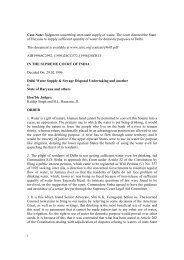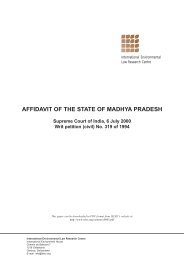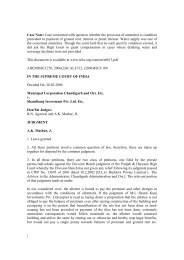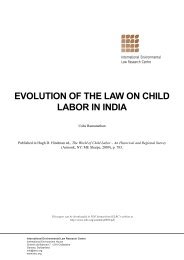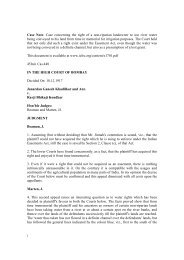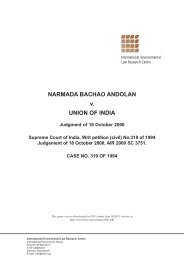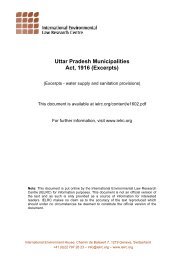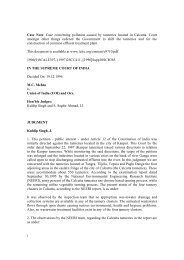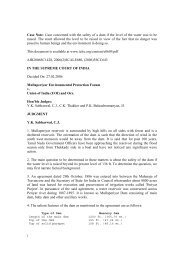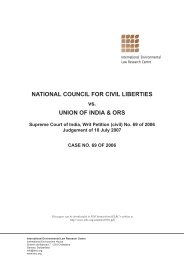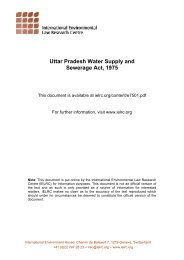Definition of an Environmental Right in a Human Rights Context
Definition of an Environmental Right in a Human Rights Context
Definition of an Environmental Right in a Human Rights Context
Create successful ePaper yourself
Turn your PDF publications into a flip-book with our unique Google optimized e-Paper software.
Cullet / <strong>Def<strong>in</strong>ition</strong> <strong>of</strong> <strong>an</strong> <strong>Environmental</strong> <strong>Right</strong> <strong>in</strong> a Hum<strong>an</strong> <strong>Right</strong>s <strong>Context</strong>elements. In most <strong>in</strong>st<strong>an</strong>ces, the right recognized is a right to a healthy or cle<strong>an</strong> environmentor <strong>an</strong> environment conducive to well-be<strong>in</strong>g <strong>an</strong>d higher st<strong>an</strong>dards <strong>of</strong> liv<strong>in</strong>g, all <strong>of</strong> which centreon the quality <strong>of</strong> life <strong>of</strong> the better-<strong>of</strong>f throughout the world." Some bolder formulationsspeak <strong>of</strong> a right to a decent environment encompass<strong>in</strong>g social <strong>an</strong>d cultural aspects that take,e.g. <strong>in</strong>to account the suitability <strong>of</strong> a given environment to <strong>an</strong> <strong>in</strong>dividual or a people accord<strong>in</strong>gto its social <strong>an</strong>d cultural needs <strong>an</strong>d thus acknowledge the <strong>in</strong>terdependence <strong>of</strong> all elements <strong>of</strong>the hum<strong>an</strong> environment." F<strong>in</strong>ally, a number <strong>of</strong> <strong>in</strong>struments recognize the l<strong>in</strong>k between theprotection <strong>of</strong> the environment <strong>an</strong>d development. This was first envisaged <strong>in</strong> a b<strong>in</strong>d<strong>in</strong>g<strong>in</strong>strument <strong>in</strong> the Afric<strong>an</strong> Charter. 2 oTwo different trends c<strong>an</strong> be identified <strong>in</strong> the history <strong>of</strong> these provisions. First, at the UNlevel, the references to a right to environment have become over the last 20 years less <strong>an</strong>dless clear even though a great number <strong>of</strong> <strong>in</strong>struments do acknowledge the relationshipbetween hum<strong>an</strong> rights <strong>an</strong>d environmental protection. 21 Second, conservation <strong>of</strong> theenvironment has become over the years <strong>in</strong>tr<strong>in</strong>sically enmeshed with development. If peoplemay have been able to speak <strong>of</strong> environmental protection for itself at the 1972 StockholmConference on the Hum<strong>an</strong> Environment, everyth<strong>in</strong>g tends to be put today under the head<strong>in</strong>g<strong>of</strong> susta<strong>in</strong>able development that supposedly reflects the <strong>in</strong>tegration <strong>of</strong> developmental <strong>an</strong>denvironmental concerns. 22 The concept <strong>of</strong> susta<strong>in</strong>able development, however welcome itmay be <strong>in</strong> allow<strong>in</strong>g all countries, <strong>of</strong>ficial <strong>an</strong>d private agencies to speak the same l<strong>an</strong>guage <strong>an</strong>dshare the same rhetoric, is not well def<strong>in</strong>ed <strong>an</strong>d clearly ambiguous <strong>in</strong> its orientation. In most<strong>of</strong> the recent documents, what is me<strong>an</strong>t by development is not the comprehensive process<strong>in</strong>volv<strong>in</strong>g social, economic <strong>an</strong>d cultural elements that was outl<strong>in</strong>ed <strong>in</strong> the Declaration on theright to development, but ma<strong>in</strong>ly economic growth.' Moreover, <strong>in</strong> the discussion onsusta<strong>in</strong>able development, economic development tends to take precedence over environmentalprotection." Thus, <strong>in</strong> the Rio Declaration, what is at stake is the relationship betweeneconomic growth <strong>an</strong>d environmental protection rather th<strong>an</strong> development, hum<strong>an</strong> rights <strong>an</strong>dthe environment. The problem is then that economic growth is seen as the first element <strong>in</strong>the relationship between development <strong>an</strong>d environment <strong>an</strong>d that the hum<strong>an</strong> rights dimensionis E.g. Article 11, Additional Protocol to the Americ<strong>an</strong> Convention on Hum<strong>an</strong> <strong>Right</strong>s <strong>in</strong> the Area <strong>of</strong>Economic, Social <strong>an</strong>d Cultural <strong>Right</strong>s - 'Protocol <strong>of</strong> S<strong>an</strong> Salvador' (repr<strong>in</strong>ted <strong>in</strong>: 28 LM 1989, p. 156),<strong>an</strong>d the draft UN Economic Commission for Europe Charter on <strong>Environmental</strong> <strong>Right</strong>s <strong>an</strong>d Obligations,adopted 29-31 October 1990, Pr<strong>in</strong>ciple 1 (UN Doc. ENVWA/R.38, Annex 1).1 Declaration <strong>of</strong> the United Nations Conference on the Hum<strong>an</strong> Environment (the Stockholm Declaration),Pr<strong>in</strong>ciple 1 (UN Doc. A/Conf.48/14/Rev. 1).20 Afric<strong>an</strong> Charter on Hum<strong>an</strong> <strong>an</strong>d Peoples' <strong>Right</strong>s, Article 24 (repr<strong>in</strong>ted <strong>in</strong>: 21 iLM 1982, p. 58).21 Pr<strong>in</strong>ciple 1 <strong>of</strong> the Stockholm Declaration thus appears retroactively one <strong>of</strong> the most boldest formulations(above note 19).E.g. Pr<strong>in</strong>ciple 4 <strong>of</strong> the Rio Declaration on Environment <strong>an</strong>d Development (UN Doc. A/CONF.151126(Vol. 1), Report <strong>of</strong> the UNCED, Rio de J<strong>an</strong>eiro, 3-14 June 1992, Annex I).23 UN General Assembly Resolution 41/128, 4 December 1986, Declaration on the <strong>Right</strong> to Development(UN Doc. ST/HR/1/Rev.4 (Vol.I/Part.2)).2 E.g. Pr<strong>in</strong>ciple 3 <strong>of</strong> the Rio Declaration (above note 22) <strong>an</strong>d Article 11 <strong>of</strong> the Vienna Declaration (abovenote 14). The doctr<strong>in</strong>e <strong>an</strong>d some operational agencies <strong>of</strong> the UN system have come to <strong>an</strong>alyze developmentover time as a comprehensive process whose realization is dependent upon the realization <strong>of</strong> hum<strong>an</strong> rights<strong>an</strong>d environmental protection, <strong>an</strong>d that is not to be primarily based upon economic growth. However, evenwith<strong>in</strong> the UNDP that seems most adv<strong>an</strong>ced <strong>in</strong> this regard, susta<strong>in</strong>able hum<strong>an</strong> development is regarded as'development that not only generates economic growth' but other benefits as well (UN Doc. DP/1994/39,§ 12). Susta<strong>in</strong>able development thus seems to be first associated with growth before tak<strong>in</strong>g <strong>in</strong>to accountthe hum<strong>an</strong> or environmental dimension.29He<strong>in</strong>Onl<strong>in</strong>e -- 13 Neth. Q. Hum. Rts. 29 1995



